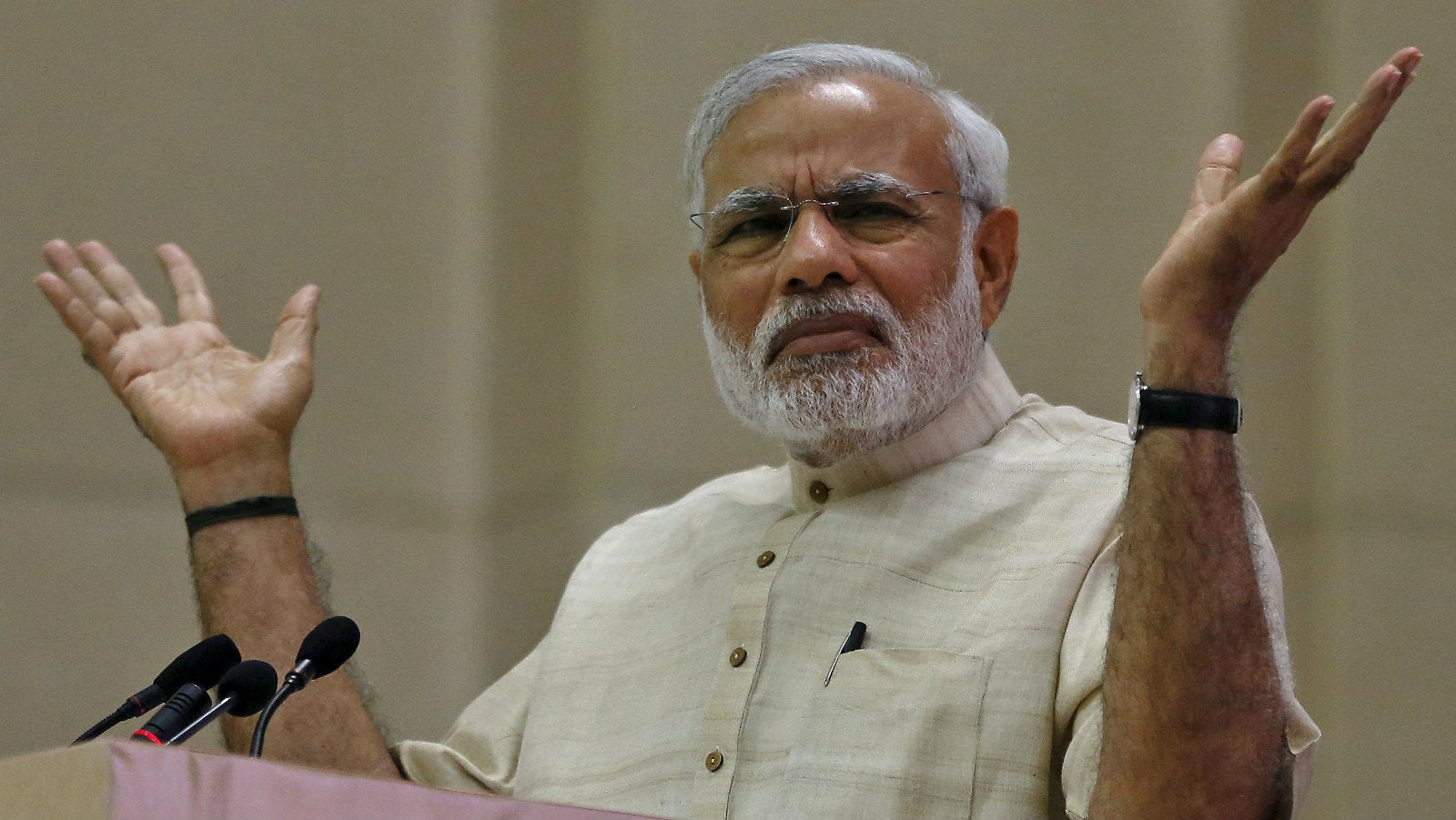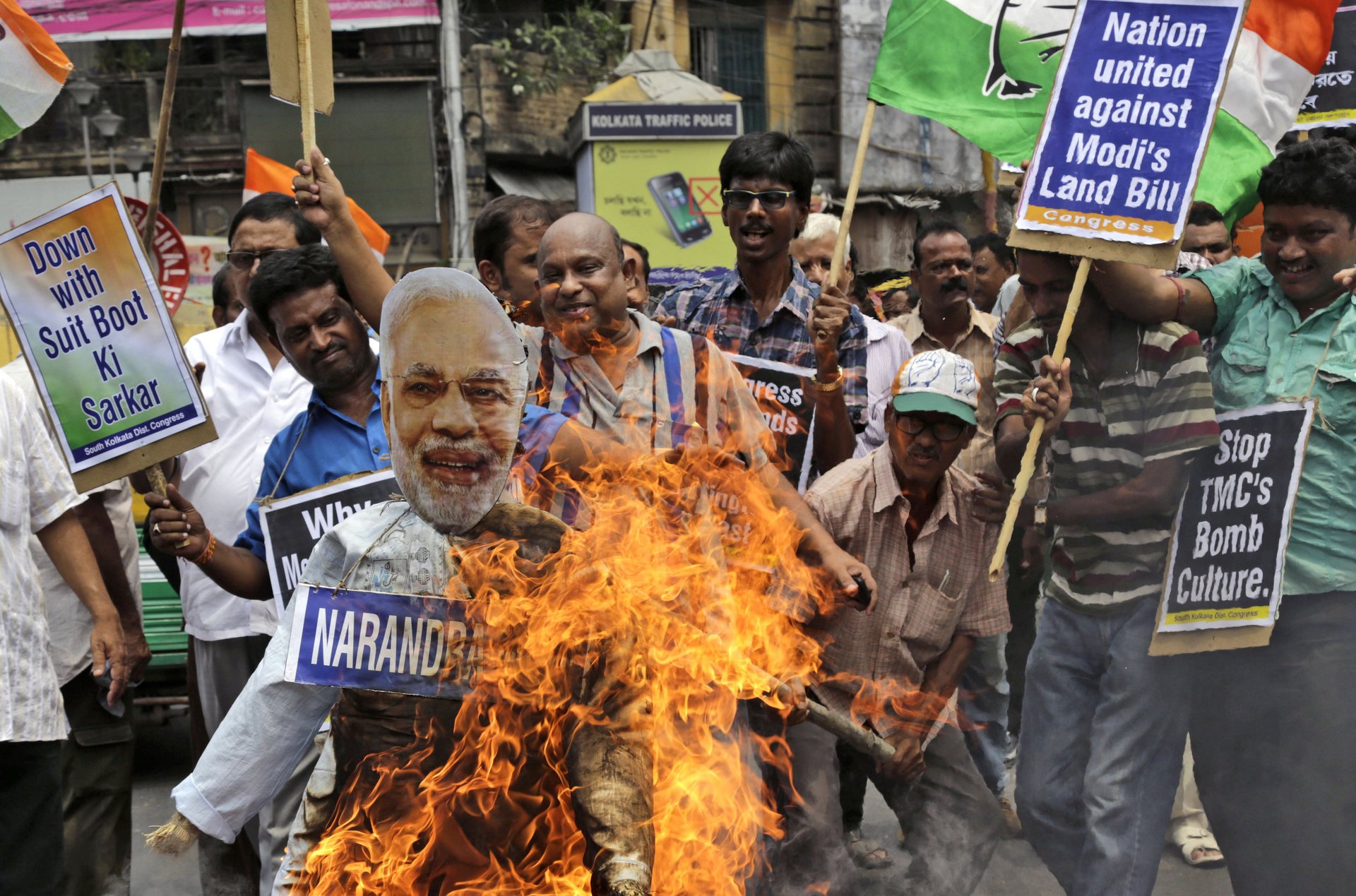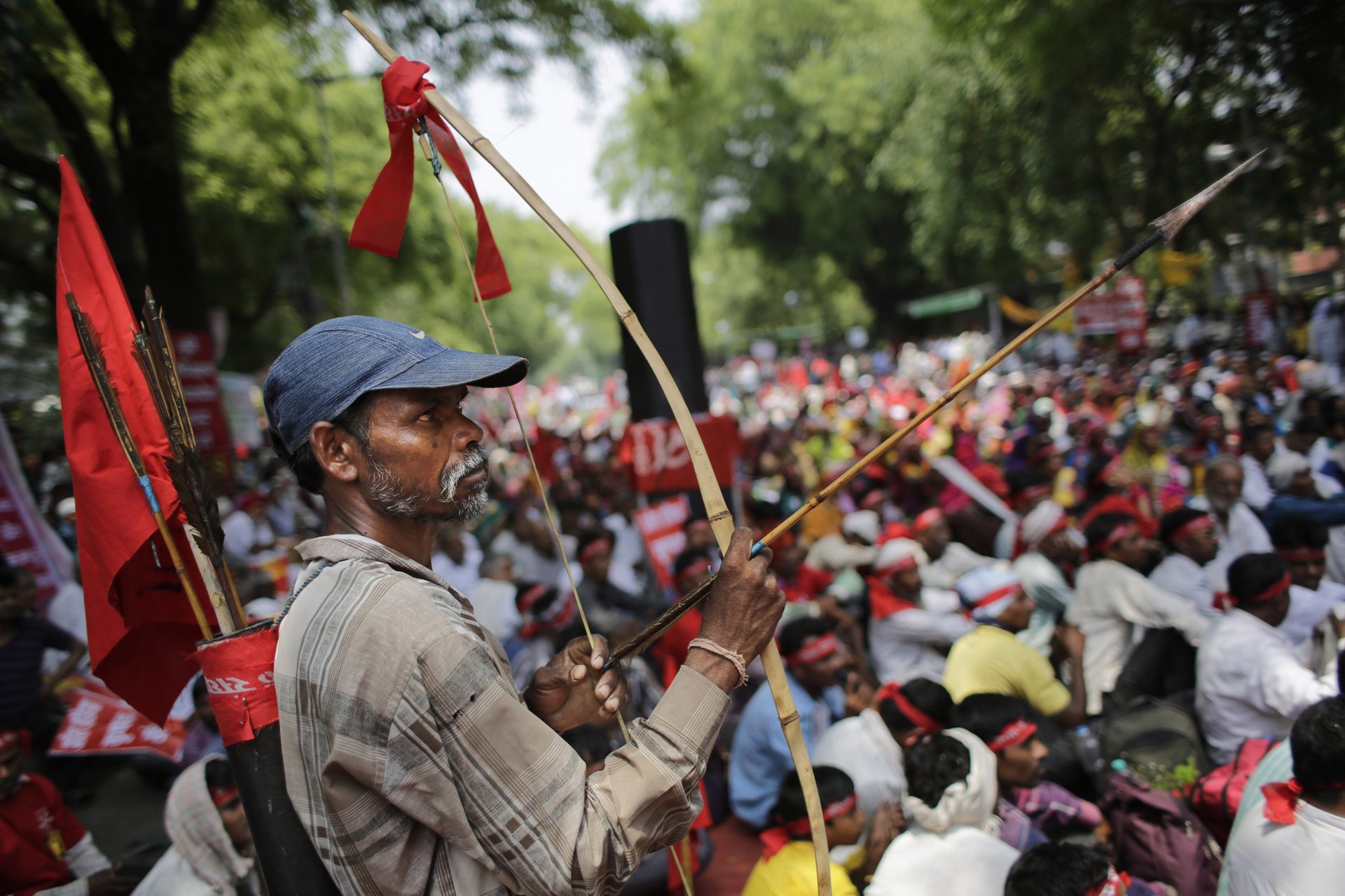Timeline: 200 years of India’s struggle with land acquisition laws
Narendra Modi’s ambitious plan to revive India’s economy has received a major setback.


Narendra Modi’s ambitious plan to revive India’s economy has received a major setback.
On Aug. 3, India’s opposition managed to stop a refurbished and contentious land acquisition bill that Modi and his government had been pushing for in the past few months. The bill will now be reworked and most likely be similar to the country’s existing land acquisition law.
After coming to power in May 2014, the new government had introduced nine key amendments to the earlier law that was passed in 2013. According to the new bill, a mandatory social impact assessment and a consent clause—70% consent from landholders for public-private partnership (PPP) projects, and 80% for private projects—were done away with in the case of five categories of projects. These included defence, rural infrastructure, affordable housing, industrial corridors, and infrastructure.
The caving-in could be a major setback for Modi’s ambitious “Make in India” campaign to boost manufacturing. Estimates suggest that projects worth Rs53,000 crore ($9 billion) are stuck due to land acquisition problems.
But such controversy over land acquisition legislation in India isn’t new. In fact, it’s been the case for almost 200 years now. Here’s a timeline:
1824: The British government in India enacts the first land acquisition legislation. It is called the Bengal Resolution I of 1824 and applies to the entire “Bengal province subject to the presidency of Fort William.” The law allows the government to obtain land or other immovable property required for roads, canals or other public purposes “at a fair valuation.”
1839: The Bombay presidency enacts an act similar to the Bengal Resolution I. (The Bombay presidency in those days included parts of the present-day states of Maharashtra, Gujarat, and Karnataka.)
1850: The British government implements Act XLII of 1850 (pdf) in the country to acquire land for building a rail network.
1852: The Madras presidency passes Act XX of 1852 (pdf) to facilitate the acquisition of land for public purposes. (The Madras presidency then included the present-day states of Tamil Nadu and Andhra Pradesh, parts of Odisha, Kerala, and Karnataka, and Lakshadweep.)
1857: The government enacts legislation that brings the whole of British-ruled India under one uniform land acquisition law. Act VI of 1857 removes all previous enactments relating to land acquisition. Under this act (pdf), the collector has the power to fix compensation for the acquired land, while disputes have to be referred to arbitrators, whose decision would be final.
1861: The 1857 legislation is amended owing to “unsatisfactory settlement,” “incompetence” and “corruption.”
1870: A new act (pdf) replaces arbitrators with civil courts for resolving disputes.
1894: The act of 1870 is found to be unsatisfactory, which leads to the government passing the Land Acquisition Act, 1894 (pdf). This act allows the government to forcibly acquire land from private landholders for projects of public purpose. The price for the land is determined by the government.
1948: The Indian Independence (Adaptation of Central Acts and Ordinances) Order, 1948, adopts the Land Acquisition Act, 1894 (pdf) after replacing the words “the whole of British India” with “all the provinces of India.” The British-era act is used in the same form for several decades.
1998: A new government led by the Bharatiya Janata Party proposes to amend the existing land bill.
2007: The Congress party-led United Progressive Alliance (UPA) government decides to amend the land acquisition act and introduces a bill in the parliament. The bill calls for a mandatory social impact assessment. It also proposes that the government, while acquiring the land, has to pay for loss or damages caused to the land and has to provide compensation as per prevailing market prices. A Land Acquisition Compensation Disputes Settlement Authority is to be set up at the state and central levels.
2008: The bill is subsequently referred to a standing committee on rural development and cleared by the group of ministers, set up by the UPA government, in December 2008.

2009: The Lok Sabha passes the 2007 amendment bill as the Land Acquisition (Amendment) Bill, 2009 in February. The government introduces the bill in the Rajya Sabha but is unable to ensure its passage. The bill lapses with the dissolution of the 14th Lok Sabha.
2011: After winning the general elections in 2009 once again, the UPA government introduces the Land Acquisition Rehabilitation and Resettlement Bill, 2011—a new bill which traces its roots to the 2009 version.
According to the bill, for a private project, land can be acquired only if 80% of the affected families agree to its acquisition. For a PPP project, 70% of affected families must agree. It also proposes that compensation for those affected would be set at four times the market rate in rural areas and two times the market rate in urban areas.
2013: The bill is passed.
Jan. 2014: The bill comes into effect.
Dec. 2014: After winning elections in May 2014, the Narendra Modi government changes the land acquisition rules by an ordinance.
According to the amendment, the consent clause and the social impact assessment are not necessary if land is acquired for national security, defence, and rural and social infrastructure. “Such projects are vital to national security and defence of India including preparation for defence and defence production,” India’s finance minister Arun Jaitley says on Dec. 29.
Feb. 2015: Social activist Anna Hazare protests against the changes made to the land bill. “How can you take away land without farmer’s consent? India is an agricultural country. The government must think about the farmers. The land ordinance is undemocratic,” Hazare says on Feb. 23.
The government tables the land acquisition amendment bill 2015 in the Lok Sabha, the day parliament’s budget session begins. Opposition parties protest against the bill. “It (land acquisition bill) is anti-farmer…We are going to oppose it tooth and nail, taking support from all the opposition parties,” Mallikarjun Kharge, leader of the Congress party, says on Feb. 24.

March 2015: The lower house, where Modi holds a majority, passes the bill. Opposition parties including the Congress, the Trinamool Congress, the Samajwadi Party and the RJD walk out of the Lok Sabha. Even the BJP’s ally, the Shiv Sena, abstains from voting. The government, meanwhile, re-promulgates the ordinance after it lapses.
April 2015: Opposition parties continue to fight against the bill. “Modi has taken loan from corporates to win elections. Now it is payback time for him. That is why his government is weakening the economic base of farmers,” Rahul Gandhi, vice president of the Congress party, says on April 19.
May 2015: The Lok Sabha refers the bill to a joint parliamentary committee consisting of 30 members. The committee comprises members from both the Lok Sabha and the Rajya Sabha. The committee is also asked to submit the report during the monsoon session of the parliament.
Meanwhile, the government remains defiant and says that they won’t back down from the bill. “There is no question of going back on the bill… Whatever is in the interests of the nation will be done forcefully,” Nitin Gadkari, India’s road transport minister, says on May 19.
June 2015: The government once again promulgates the ordinance. Three Delhi-based NGOs and the Bharatiya Kisan Union challenge it at the supreme court of India. “The action of the government in promulgating successive ordinances, bypassing the legislative process of parliament, is not only arbitrary and violative of Article 14 of the Constitution but is also a fraud on the Constitution,” the petition says.
July 2015: The joint committee that was to submit its report seeks a two-week extension.
August 2015: A joint parliamentary panel suggests that the government withdraw six key amendments, including the plan to remove the consent clause and the social impact assessment.